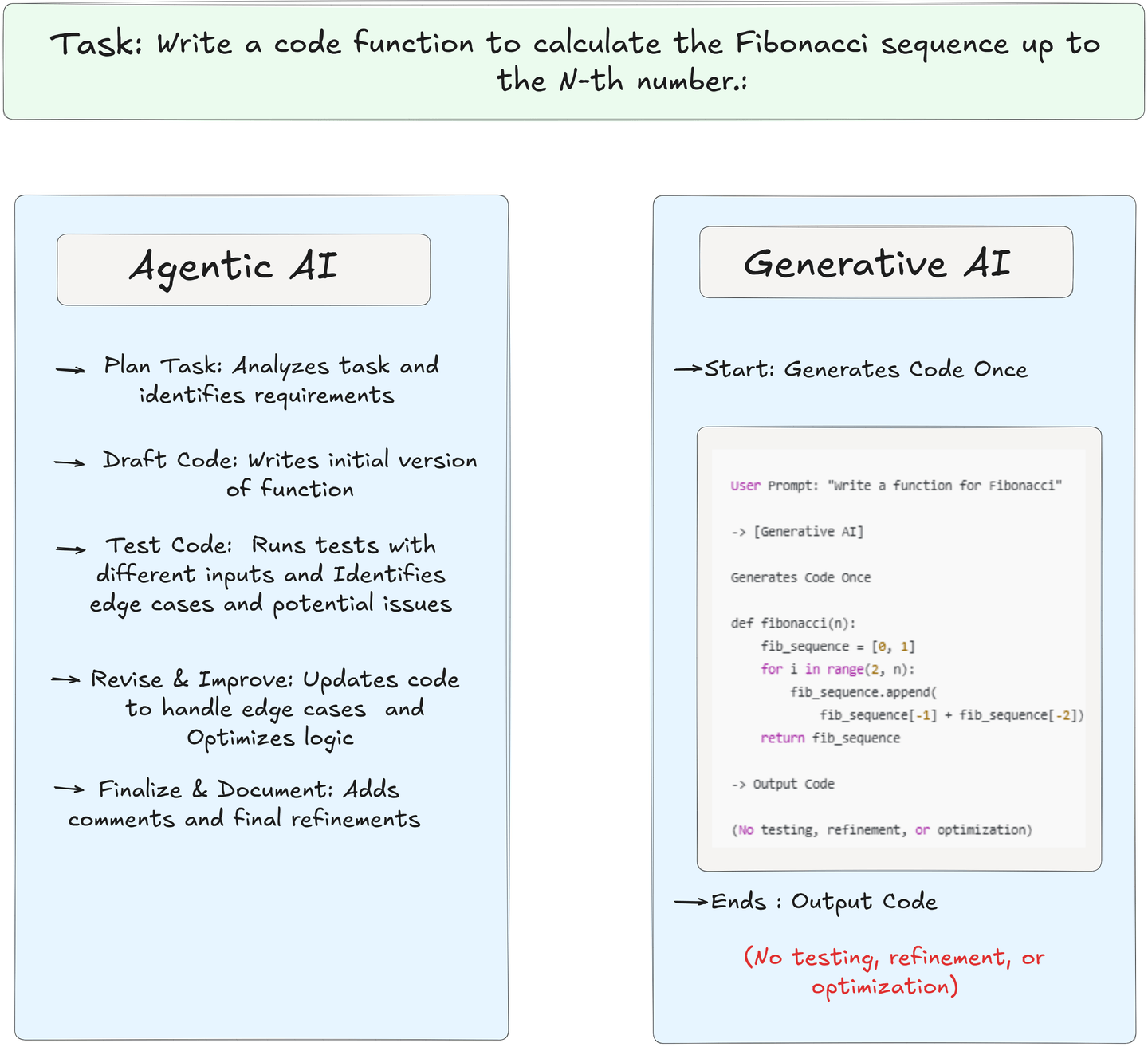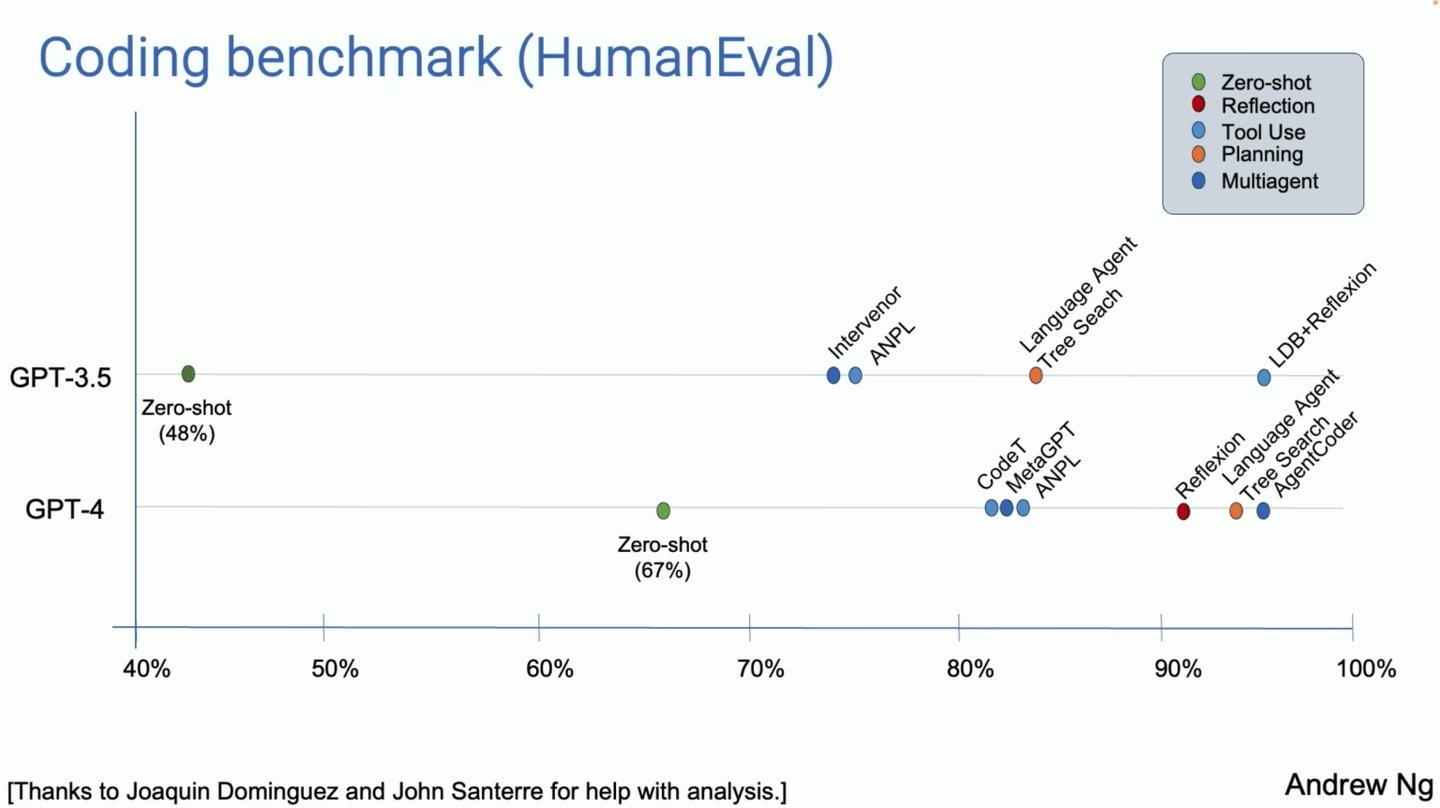Large Language Models (LLMs) (opens new window) like GPT (opens new window) can generate text, answer questions, and assist with many tasks. However, they are reactive, meaning they only respond to the input they receive based on patterns they've learned. LLMs can't make their own decisions; other than that, they can't plan or adapt to changing situations.

Agentic AI (opens new window) comes into play to resolve this issue. Unlike **generative AI (opens new window)** LLMs, agentic AI can take initiative, set goals, and learn from its experiences. It is proactive, able to adjust its actions over time, and can handle more complex tasks that require ongoing problem-solving and decision-making. This shift from reactive to proactive AI opens up new possibilities for technology across many industries.
In this blog series, we will break down the differences between Agentic AI and Generative AI, looking at how each affects industries and the future of technology. In this first post, we'll start by exploring what sets these two types of AI apart.
# Agentic AI
Agentic AI refers to AI systems that can make decisions and take actions autonomously to accomplish specific goals. Instead of simply generating content, these AI models can interact with their surroundings, respond to changes, and complete tasks with minimal human guidance. For example, a virtual assistant with agentic capabilities might not only provide information but also schedule appointments, manage reminders, or perform other actions to help the user achieve their goals. Similarly, self-driving cars exemplify agentic AI, as they make real-time decisions to safely navigate roads and reach destinations independently.
# Generative AI
Generative AI is a type of artificial intelligence focused on creating new content, such as text, images, music, or even video. It works by learning from vast amounts of data to understand patterns, styles, or structures, and then generates original content based on what it has learned. For instance, a generative AI like ChatGPT can produce unique text responses to questions, while image-generating models like DALL-E can create images from text descriptions. Essentially, generative AI is like a digital artist or writer, producing creative work based on what it has learned.

The illustration above highlights how Agentic AI works through an iterative, cyclical workflow that includes stages of "Thinking/Research" and "Revision." This adaptive process involves continuous self-assessment and improvement, enabling Agentic AI to produce a higher-quality, optimized output. By taking multiple steps to test and refine its work, Agentic AI can operate independently, learn from each stage, and tackle tasks that demand ongoing evaluation and adjustment.
# Characteristics of Agentic AI and GenAI
This section explores Agentic AI and GenAI's unique characteristics, highlighting their distinct approaches to intelligence, autonomy, and decision-making.

- Autonomy: Agentic AI can act independently without requiring constant input from humans. It makes decisions and carries out tasks on its own. Think of it like a robot that operates without a human controller, determining what to do next based on its surroundings.
- Goal-Directed Behavior: Agentic AI operates with a clear goal in mind. It doesn't just respond to the world at random; it actively works toward something specific. For example, a self-driving car strives to get you to your destination safely, and every action it takes, from steering to braking, serves that goal.
- Adaptation and Learning: The Agent learns from its actions and experiences. When it encounters a problem or failure, it adjusts. For instance, an AI that recommends movies learns which movies you prefer and improves over time to provide you with better suggestions.
- Complex Decision-Making: Agentic AI doesn’t just make simple choices; it evaluates many options and considers outcomes. Imagine an AI that controls a stock-trading algorithm: it analyzes tons of data, predicts trends, and decides whether to buy or sell stocks based on that information.
- Environmental Perception: For AI to make smart choices, it needs to understand its environment. It does this through sensors or data. A robot, for example, uses cameras to "see" obstacles and then navigates around them.
- Limited Autonomy: Generative AI has limited autonomy. It doesn’t act independently and requires human input to generate responses. It processes the input it receives and produces output based on learned patterns, but it cannot initiate actions or operate without external prompts.
- Task-Oriented Behavior: Generative AI is task-oriented but only in a reactive sense. It responds to specific prompts or tasks by generating relevant content, such as text or images, but it doesn't pursue long-term objectives or have an overarching goal. Each task is completed based on immediate input.
- Basic Decision-Making: Generative AI engages in basic decision-making. It selects outputs based on patterns it has learned, but it doesn’t evaluate multiple alternatives or consider consequences. For example, when generating text, it picks the most likely next word or phrase based on training, but it doesn’t make complex, layered decisions.
- No Learning or Adaptation: Generative AI does not learn or adapt in real-time. Once trained, it operates based on the patterns it learned during training, but it does not change or improve its performance based on new interactions unless retrained with updated data.
- No Environmental Perception: Generative AI has no environmental perception. It works with data (e.g., text, images) but cannot sense or interpret the physical environment. It cannot understand its surroundings and only reacts to the input it is given, without any external awareness.
# Case Study: Agentic Workflow in Action
While the theoretical distinctions between Generative AI and Agentic AI are clear, seeing these concepts in action is where the true potential of Agentic AI becomes evident. To demonstrate its practical value, let's explore a case study that showcases how Agentic AI outperforms traditional LLM methods in real-world scenarios.
Andrew Ng shared a case study to highlight the power of the Agentic Workflow in coding tasks. His team tested two methods using the HumanEval coding benchmark. The task was: “Given a list of integers, return the sum of all even-positioned elements.” In the first method, zero-shot prompting (opens new window), the AI was simply asked to solve the problem directly without any extra steps. For example, GPT-3.5 scored 48% accuracy, and GPT-4 did better with 67%. These results were good, but not exceptional.
# Quick Terms:
- Zero-shot prompting: Asking the AI to solve a problem without providing additional guidance or breaking it down into smaller steps.
- Agentic Workflow: A method where a task is split into smaller phases, like understanding, coding, testing, and debugging, allowing the AI to iterate and improve over time.

However, when the team applied the Agentic Workflow, which breaks the task into smaller steps like understanding the problem, writing the code in parts, testing, and fixing errors, GPT-3.5 performed even better than GPT-4. Ng pointed out that GPT-4 also showed stronger results when using the Agentic Workflow. This shows that by taking a step-by-step approach, AI models—especially older ones—can outperform more advanced models using traditional methods like zero-shot prompting.
# Conclusion
As AI becomes a bigger part of our lives and workplaces, it’s very important to understand the differences between Agentic AI and Generative AI. Generative AI has been very helpful in tasks like text generation, responding to prompts by generating text or images. But it’s limited to following instructions without real autonomy. Agentic AI, on the other hand, is a step forward—it can set goals, make decisions, and adapt to changing situations on its own, taking on complex tasks without constant human guidance.
By using methods like the Agentic Workflow, AI systems can become more effective, improving performance through iterative steps and learning from each phase. This shift opens up opportunities for advanced applications and allows even older models to keep evolving and stay relevant. In the next parts of this series, we’ll explore how Agentic AI works in practice and its potential to reshape industries and drive new innovations.




